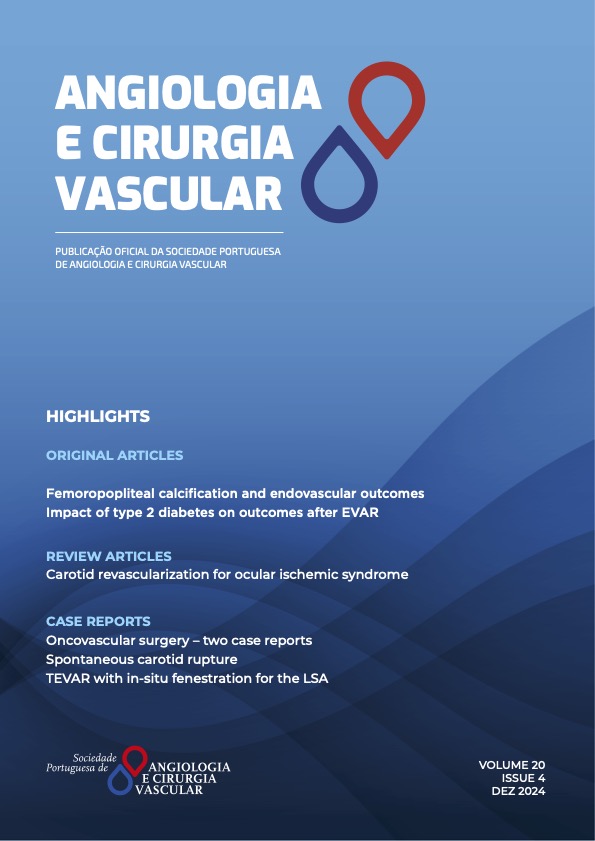In-situ needle fenestration technique for preserving the left subclavian artery in emergent TEVAR
DOI:
https://doi.org/10.48750/acv.624Keywords:
Thoracic aortic aneurysm, endovascular repair, TEVAR, In situ Fenestration, Left subclavian artery fenestrationAbstract
BACKGROUND: Open aortic repair is the gold standard in the treatment of diseases involving the aortic arch, but high-risk patients are often not suitable candidates for surgical repair. Thoracic endovascular aortic repair (TEVAR) is less invasive; however, endovascular repair including the aortic arch remains a challenge. LSA revascularization is linked with reduced risk of cerebrovascular events, spinal cord ischemia, and upper limb ischemia at the cost of complications associated with carotid-subclavian bypass. In-situ fenestration (ISF) seems an effective, safe, and feasible method for the totally endovascular aortic arch repair avoiding the risks associated with bypass surgery. This technique allows for rapid, “off-the-shelf” repair of arch lesions with minimal physiologic disturbances and lower perioperative complications.CASE REPORT: An 86-year-old man is admitted to the emergency room due to chest pain and hoarseness. There was a previous medical history of TEVAR (proximally implanted in zone 3) for penetrating thoracic aortic; 8 months prior. Computed tomography angiography revealed aneurysmal dilation of the lesser curvature of the aortic arch with a maximum diameter of 65mm. The patient was submitted to TEVAR with proximal sealing in zone 2 of the arch (Ankura™ stent-graft) and revascularization of the left subclavian artery (LSA) was achieved using an ISF by needle fenstration with the deployment of a balloon-expandable covered stent. No complications were registered. Patient initiated broad spectrum antibiotics and underwent positron emission tomography revealing several metabolically active lymph nodes suggesting underlying neoplasm.
CONCLUSION: ISF, due to its relative simplicity, is also suitable in urgent and emergent settings. It is a simple, quick technique to be added to our arsenal of endovascular procedures on the aortic arch. It may avoid the carotid-subclavian bypass as well as intentional embolization of the LSA in urgent/emergent patients. Prospective studies with long-term clinical follow-up are still lacking to fully assess the durability of these fenestrations.
Downloads
References
Li HL, Chan YC, Jia HY, Cheng SW. Methods and clinical outcomes of in situ fenestration for aortic arch revascularization during thoracic endovascular aortic repair. Vascular. 2020;28:333-41.
Diffaretti G, Franchin M, Onesutta A, Ferlanga B, Orrico M, Mariscalco G, et al. Anatomic Feasibility of In-Situ Fenestration for Isolate Left Subclavian Artery Preservation during Thoracic Endovascular Aortic Repair Using an Adjustable Needle Puncturing System. J Clin Med. 2024;13:162.
Li C, Xu P, Hua Z, Chen M, Zhang X, Li Y, et al. Early and midterm outcomes of in situ laser fenestration during thoracic endovascular aortic repair for acute and subacute aortic arch diseases and analysis of its complications. J Vasc Surg. 2020;72:524-33.
Wang X, Wu J, Zhi K, Xu W, Liu M, Zhang Y, et al. Comparative effectiveness and safety of laser, needle, and "quick fenestrator" in in situ fenestration during thoracic endovascular aortic repair. Front Cardiovasc Med. 2023;10:1-8.
Yu Z, Hu S, Wang D, Yang T, Lang D. Early and midterm outcomes of in situ fenestration via adjustable puncture needle for Ankura aortic stent graft: A single-center experience. Vascular. 2024;32:964-72.
Ye P, Miao H, Zeng Q, Chen Y. Comparison of total percutaneous in situ microneedle puncture and chimney technique for left subclavian artery fenestration in thoracic endovascular aortic repair for type B aortic dissection. Eur Radiol. 2024;34:7136-44.









